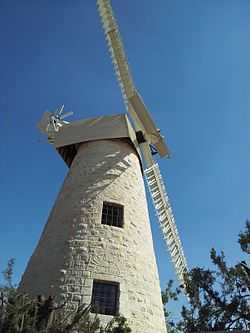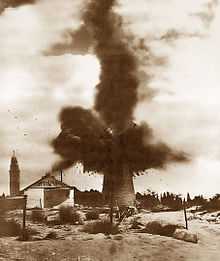Montefiore Windmill
| Montefiore Windmill | |
|---|---|
 Montefiore Windmill, 23 August 2012 | |
| Origin | |
| Mill name |
Montefiore Mill Jaffa Gate Mill |
| Mill location |
Jerusalem, Israel 31°46′17.31″N 35°13′27.03″E / 31.7714750°N 35.2241750°E |
| Year built | 1857 |
| Information | |
| Purpose | Flour mill |
| Type | Tower mill |
| Storeys | Four storeys |
| Number of sails | Four sails |
| Type of sails | Patent sails |
| Windshaft | Cast iron |
| Winding | Fantail |
| Fantail blades | Six blades |
| Auxiliary power | Electric motor |
| Number of pairs of millstones | Two pairs |
The Montefiore Windmill (less-commonly known as the Jaffa Gate Mill)[1] is a landmark windmill in Jerusalem, Israel. Built in the Mishkenot Sha'ananim neighborhood in 1857, which was then in Ottoman-ruled Palestine, it was designed as a flour mill. The windmill serves as a small museum honored and dedicated to the achievements of British Jewish banker and philanthropist Moses Montefiore. It was restored in 2012 with a new cap and sails in the style of the originals. The mill can turn in the wind.
History

The windmill was funded by the British Jewish banker and philanthropist Moses Montefiore, who devoted his life to promoting industry, education and health in the Holy Land.[2] Montefiore built the windmill with funding from the estate of an American Jew, Judah Touro, who appointed Montefiore executor of his will.[3] Montefiore mentions the windmill in his diaries (1875), noting that he had built it 18 years ago on the estate of Kerem-Moshe-ve-Yehoodit, and that it had since been joined by two other windmills nearby, owned by Greeks.[4] The project, bearing the hallmarks of nineteenth century artisan revival, aimed to promote productive enterprise in the Yishuv.
The mill was designed by Messrs Holman Brothers, the Canterbury, Kent millwrights. The stone for the tower was quarried locally. The tower walls were 3 feet (910 mm) thick at the base and almost 50 feet (15.24 m) high. Parts were shipped to Jaffa, where there were no suitable facilities for landing the heavy machinery. Transport of the machinery to Jerusalem had to be carried out by camel. In its original form, the mill had a Kentish-style cap and four Patent sails. It was turned to face into the wind by a fantail. The mill drove two pairs of millstones, flour dressers, wheat cleaners and other machinery.[1]
The construction of the mill was part of a broader program to enable the Jews of Palestine to become self-supporting. Montefiore also built a printing press and a textile factory, and helped to finance several agricultural colonies. He attempted to acquire land for Jewish cultivation, but was hampered by Ottoman restrictions on land sale to non-Muslims.
The mill was not a success due to a lack of wind.[5] Wind conditions in Jerusalem could not guarantee its continued operation. There were probably no more than 20 days a year with strong enough breezes. Another reason for the mill's failure was technological. The machinery was designed for soft European wheat, which required less wind power than the local wheat. The first steam-powered mill was built in Jerusalem in 1878.[6]
The Montefiore windmill was phased out by 1891 but restored in 2012.
Anecdotes

Two anecdotes about the windmill appear in a 1933 book, which refers to it as the Jaffa Gate Mill. The first is that there was much opposition from among the local millers to the windmill, who looked upon it with the evil eye and sent their head man to curse it. Predictions were made that the mill would be washed away during the rainy season; after it survived intact, it was declared to be the work of Satan. The second is that the Arabs developed a taste for the lubricating oil on the bearings and would lick them, prompting fear the mill would burn down from the resulting friction. The solution was said to be placing a leg of pork in the oil barrel, whereafter the Arabs lost a taste for the oil.[1]
1948 War of Independence
During the Israeli War of Independence the windmill served an observation point for Jewish fighters. In an attempt to impede the Israeli defence, the British authorities blew up the top of the windmill in an operation dubbed "Operation Don Quixote."[7]
Montefiore carriage
In a glassed-in room at the windmill is a replica of the carriage Sir Montefiore used in his travels. The original carriage was brought to Palestine by Boris Schatz, the founder of the Bezalel Academy of Art, but it was destroyed in a fire in 1986.[8]
Restoration

The mill was restored in 2012 as part of the celebrations of the 60th anniversary of the founding of Israel. A Dutch organisation, "Christians for Israel" (Dutch: Stichting Christenen voor Israël), is behind the scheme. A model of Stelling Minnis windmill, built by Tom Holman, was temporarily taken to the Netherlands to help raise funds for the restoration. None of the original machinery survives.[9] Millwright Willem Dijkstra rebuilt the floors, sails, cap and machinery in his workshop in Sloten, the Netherlands in cooperation with Dutch construction company Lont and British millwright Vincent Pargeter. The windshaft was cast and machined at Sanders’ IJzergieterij en Machinefabriek B.V in Goor, the Netherlands.[10] The parts were then shipped to Israel and reassembled on site.[11] Dijkstra, his family and employee temporarily moved to Israel to help with the restoration.[10] The cap and sails were lifted into place on July 25, 2012,[12][13] and the mill was turning for the first time again on August 6.[14][15]
References
| Wikimedia Commons has media related to Moses Montefiore Windmill. |
- ↑ 1.0 1.1 1.2 Coles Finch, William (1933). Watermills and Windmills. London: C W Daniel and Company. pp. p50–52, illustration facing p224.
- ↑ Montefiore Heritage Site
- ↑ Jerusalem Simon Goldhill
- ↑ Diaries of Sir Moses and Lady Montefiore: comprising their life and work as recorded in their diaries from 1812-1883, Volume 2. Adamant Media Corporation. 2001. p. 277. ISBN 9781402193149.
- ↑ "The Windless Windmill". ohr.edu. Retrieved 2008-11-12.
- ↑ Palestine in the Late Ottoman Period , David Kushner
- ↑ Street People, Helga Dudman, Jerusalem Post/Carta, 1982, pp. 21-22
- ↑ In the shadow of the walls
- ↑ Holman, Geoff (2010). "Kent mill moved to Holland". Cant Post (Kent Mills Society) (1): p9.
- ↑ 10.0 10.1 "Bertus Dijkstra, Bouw en Molenbouw" (in Dutch). Retrieved 08-06-2012.
- ↑ Walinga, Cees (05-01-2012). "Willem Dijkstra herstelt Montefiore-molen in Jeruzalem". Balkster Courant (in Dutch). p. 7. Retrieved 25-03-12.
- ↑ "Historic Jerusalem mill gets new wind in sails". Retrieved 03-08-2012.
- ↑ "Mûne yn Jeruzalem opknapt" (in Frisian). Retrieved 03-08-2012.
- ↑ "Jerusalem Mill turns after 140 years". The Mills Archive Trust. August 7, 2012. Retrieved August 16, 2012.
- ↑ "De Montefioremolen draait weer". Alfred Muller via YouTube. 6 August 2012. Retrieved 18 August 2012.
| ||||||||||||||||||||